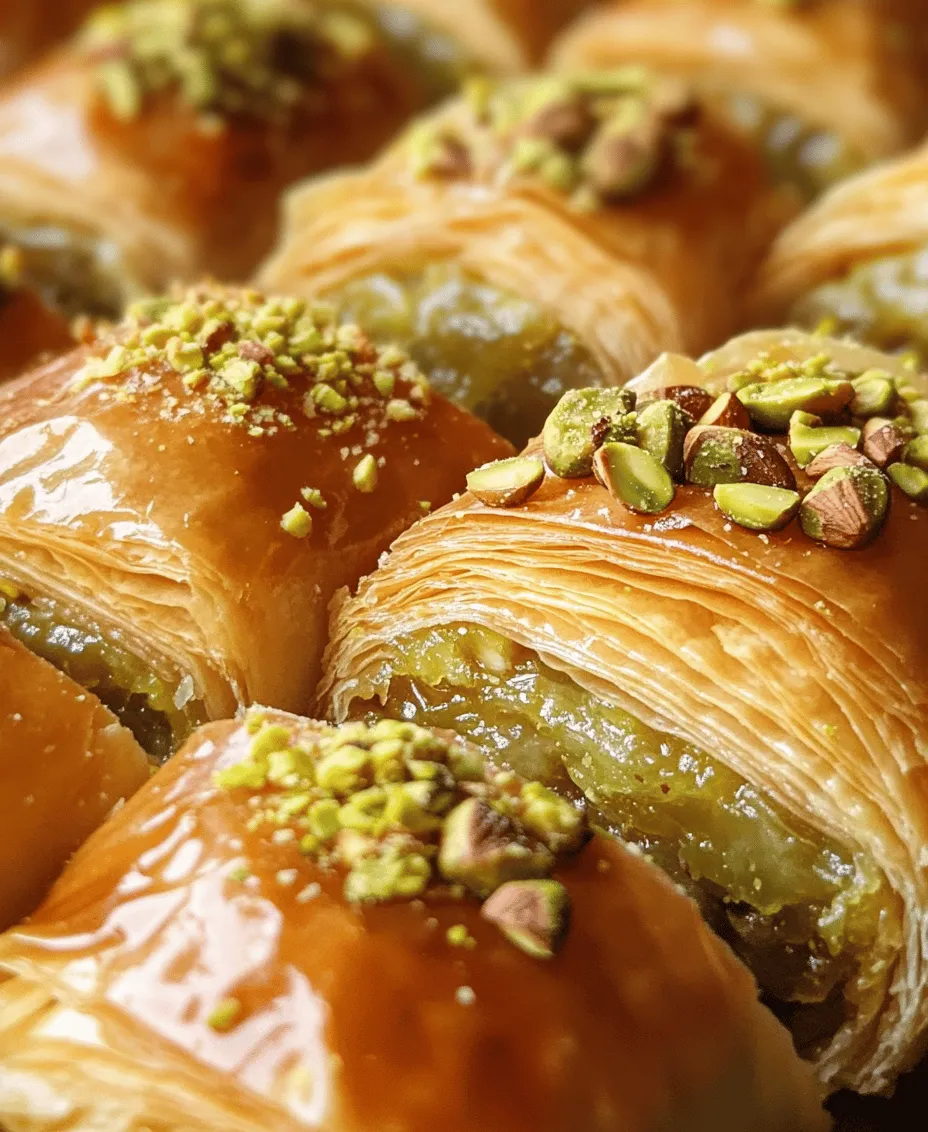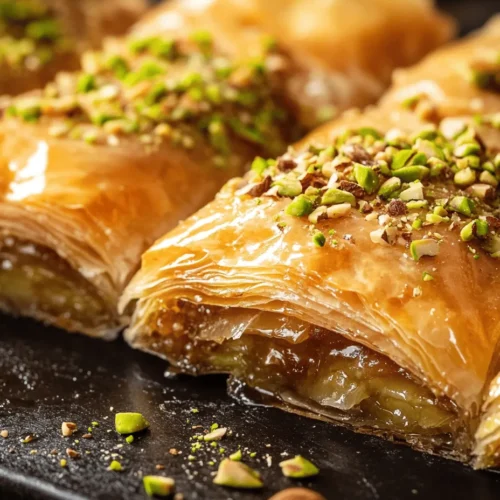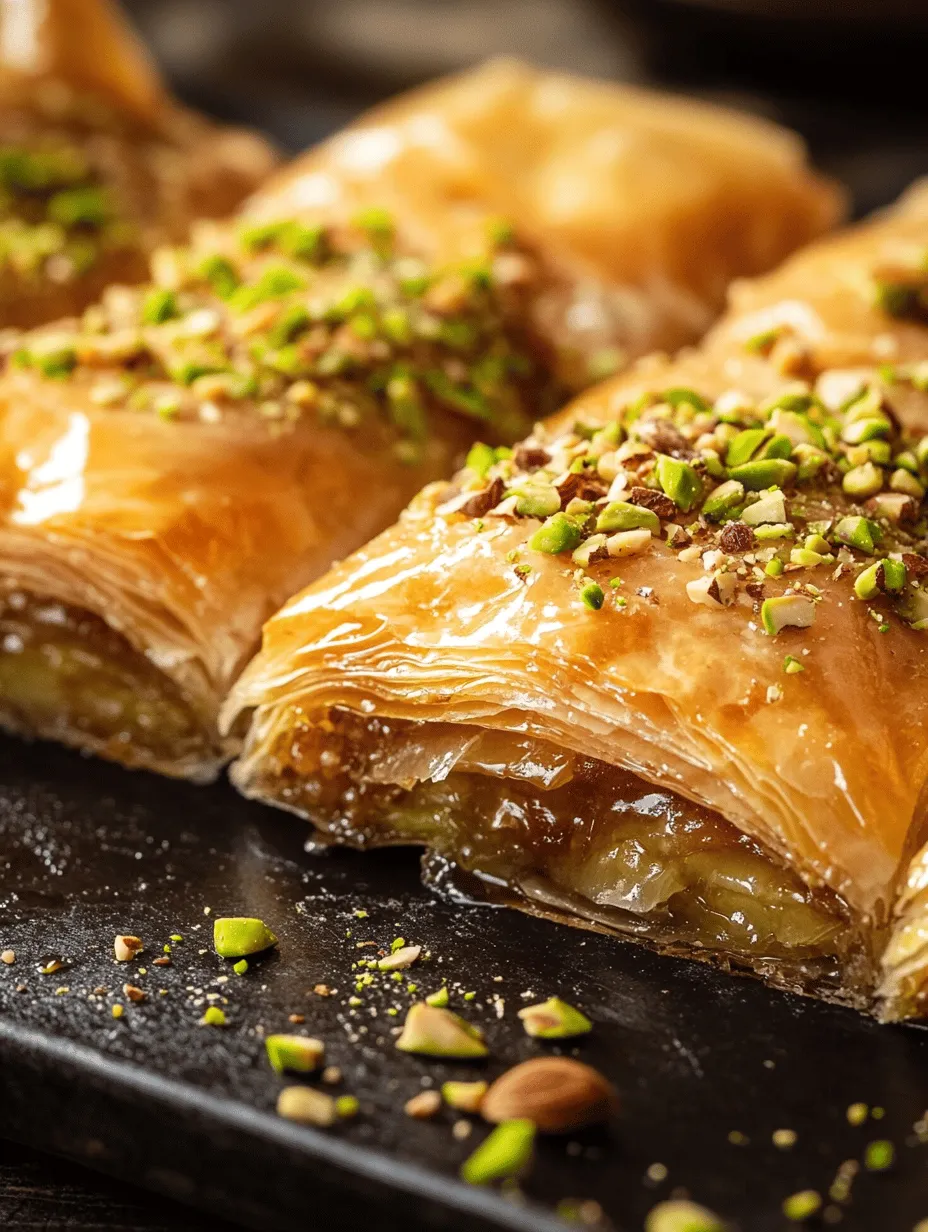Introduction
Baklava, a beloved dessert steeped in rich history and tradition, is a staple in Mediterranean and Middle Eastern cuisines. This decadent treat, made from layers of delicate phyllo pastry filled with nuts and sweetened with syrup, has captivated taste buds for centuries. Its origins are often traced back to the Ottoman Empire, where it was served in palaces and enjoyed by the elite. Today, baklava is celebrated worldwide, transcending borders and cultures, often gracing tables during festive occasions and family gatherings.
In this article, we will explore a delightful twist on the classic baklava: Baklava Rolls. These rolled versions not only provide a unique presentation but also enhance the overall enjoyment of this sweet treat. The layers of flaky phyllo dough encase a generous filling of nuts, creating an irresistible dessert that’s sure to impress. Whether you’re preparing a special occasion or simply indulging your sweet tooth, these baklava rolls will not disappoint.
The key ingredients that make baklava rolls so enticing include phyllo dough, a variety of nuts, butter, spices, and a luscious sweet syrup. Each ingredient plays a vital role in achieving the perfect balance of flavors and textures, making baklava rolls a truly delightful culinary experience.
Understanding Baklava
The history of baklava is as rich as its flavor. While the exact origins are debated, many believe that it was first created in the kitchens of the Ottoman Empire, where chefs crafted delicate pastries for the sultans. Over the centuries, baklava has evolved, with variations emerging across different cultures. In Greece, baklava is often made with walnuts and flavored with cinnamon, while in Turkey, pistachios are more commonly used, and the syrup may have a hint of rosewater or orange blossom.
Baklava is not just a dessert; it holds significant cultural importance. In many Middle Eastern cultures, it is a traditional sweet served during celebrations such as weddings, religious holidays, and family gatherings. Its elaborate preparation and luxurious ingredients symbolize hospitality and generosity. Sharing baklava with friends and family is a cherished tradition, making it a favorite during festive seasons.
Ingredients Breakdown
To create these delicious baklava rolls, you will need several key ingredients. Each plays a crucial role in building layers of flavor and texture, resulting in a dessert that is both beautiful and delectable.
1. Phyllo Dough:
Phyllo dough is the backbone of baklava, providing its signature flaky texture. This paper-thin pastry is made from flour, water, and a little salt, rolled out to create ultra-thin sheets. When baked, phyllo dough transforms into a crispy, golden delight that crumbles in your mouth. To ensure the best results, it’s important to handle phyllo dough with care. Keep it covered with a damp cloth while working to prevent it from drying out. Store any unused sheets in the refrigerator or freezer for later use.
2. Nuts (Walnuts and Pistachios):
The filling of baklava is typically composed of finely chopped nuts, with walnuts and pistachios being the most popular choices. Walnuts offer a rich, earthy flavor, while pistachios add a delightful sweetness and vibrant green color. Both nuts are packed with nutritional benefits, including healthy fats, protein, and fiber. When preparing the filling, aim for a coarse texture to ensure the nuts provide a satisfying crunch without overwhelming the delicate phyllo layers.
3. Butter:
Butter is essential for achieving that perfect flaky texture in baklava rolls. The melted butter acts as a binding agent, allowing the layers of phyllo to adhere together while also providing rich flavor. Brush each layer generously with melted butter before layering to ensure optimal crispiness. For a slightly healthier alternative, you can use a blend of melted butter and oil.
4. Spices and Flavorings:
To elevate the flavor profile of baklava, spices such as cinnamon and nutmeg are often incorporated into the nut filling. A splash of vanilla extract can also enhance the overall taste. Additionally, a hint of lemon juice in the syrup adds brightness and balances the sweetness, creating a more complex flavor experience.
5. Sweet Syrup:
The syrup is what brings baklava to life, enveloping each roll in sweetness. A traditional baklava syrup is made from a combination of sugar, honey, and water. The goal is to achieve the right consistency; it should be thick enough to coat the rolls but not overly sticky. Adding a splash of lemon juice to the syrup not only enhances the flavor but also helps prevent crystallization.
Preparing the Filling
Now that you have a better understanding of the key ingredients, it’s time to prepare the nut filling for your baklava rolls. Follow these simple steps to achieve the perfect filling:
1. Chop the Nuts:
Begin by finely chopping your nuts—walnuts and pistachios. You can use a food processor for a quick and even chop, but be careful not to over-process them into a powder. You want a coarse texture that will provide a satisfying crunch in every bite.
2. Mix in the Spices:
In a large mixing bowl, combine the chopped nuts with ground cinnamon, nutmeg, or any additional spices you prefer. This step will infuse the nuts with flavor, enhancing the overall taste of your baklava rolls. If you like a hint of sweetness, consider adding a tablespoon of sugar to the nut mixture as well.
3. Customize Your Filling:
Feel free to experiment with different nuts or spices to create a filling that suits your taste. Almonds, hazelnuts, or even pecans can be great alternatives. For an extra layer of flavor, consider adding a splash of vanilla extract or a pinch of salt to balance the sweetness.
4. Set Aside:
Once your filling is prepared, set it aside while you move on to assembling the baklava rolls. This allows the flavors to meld together, creating a more flavorful filling.
Assembling the Baklava Rolls
Assembling your baklava rolls is where the magic happens. With the filling ready, it’s time to layer the phyllo dough and create these delicious rolls. Follow these detailed instructions for optimal results:
1. Prepare Your Workspace:
Clear a large, flat surface to work on. Make sure all your ingredients and tools (such as a pastry brush and a sharp knife) are within reach.
2. Handling the Phyllo Dough:
Carefully unroll the phyllo dough, and keep it covered with a damp cloth while you work to prevent it from drying out. If you notice any tears in the sheets, don’t worry; they can still be used, and the layers will help conceal any imperfections.
3. Layering with Butter:
Take one sheet of phyllo dough and place it on your workspace. Using a pastry brush, generously brush the sheet with melted butter. Repeat this process, layering about five sheets of phyllo dough, brushing each layer with butter to ensure that they adhere together and achieve that signature flaky texture.
4. Adding the Filling:
Once you have your layers prepared, sprinkle a generous amount of the nut filling along one edge of the phyllo dough, leaving about an inch of space from the edges. Be careful not to overfill, as this can make rolling difficult.
5. Rolling Technique:
Carefully lift the edge of the phyllo dough closest to you and begin to roll it away from you, tightly but gently, to create a cylinder. Make sure to keep the roll even as you go, tucking in the edges as necessary to prevent the filling from spilling out. Once you reach the end, brush the outside of the roll with more melted butter to help it brown beautifully during baking.
6. Repeat the Process:
Continue this process with the remaining sheets of phyllo dough and filling until all ingredients are used. Place the assembled baklava rolls on a baking sheet lined with parchment paper, ensuring they are spaced apart to allow for even baking.
With the baklava rolls assembled, you are now ready to move on to the baking process and syrup preparation, which will transform these delicious creations into the irresistible dessert you’ve envisioned. Stay tuned for the next part of this guide, where we will delve into the baking instructions and syrup-making tips that will bring your baklava rolls to life.

Baking the Rolls
Once you’ve meticulously prepared your baklava rolls, the next step is baking them to golden perfection. The importance of spacing on the baking sheet cannot be overstated. Proper spacing allows for even heat distribution, ensuring that each roll bakes uniformly. Arrange the rolled baklava on the greased baking sheet, leaving about an inch of space between each piece. This will help them expand slightly as they bake without crowding, which can lead to uneven cooking and soggy bottoms.
Oven Temperature and Baking Time
Preheat your oven to 350°F (175°C). This temperature is ideal for achieving a nicely browned exterior while allowing the filling to heat through. Bake the rolls for approximately 25 to 30 minutes, but keep a close eye on them during the last few minutes. The goal is to achieve a beautiful golden brown color, which indicates that the pastry is crisp and the nuts inside are perfectly roasted.
Signs of Doneness
To ensure your baklava rolls are cooked to perfection, look for a few key signs:
1. Color: The tops should be a deep golden brown.
2. Texture: The phyllo dough should appear crispy and flaky.
3. Aroma: As they bake, a delightful nutty aroma will fill your kitchen, signaling that they’re nearly ready.
Importance of Using a Greased Baking Sheet
Before placing your baklava rolls in the oven, be sure to grease your baking sheet. This step is crucial for preventing sticking, which can ruin the presentation of your rolls when you attempt to remove them. Use a light coating of melted butter or a non-stick spray to ensure that your baklava rolls glide off the sheet effortlessly after baking.
Making the Sweet Syrup
While the baklava rolls are baking, it’s time to prepare the sweet syrup that will soak into the rolls and provide that signature sweetness. The syrup is a simple mixture of sugar, water, and lemon juice, but each component plays an important role in creating the final flavor profile.
Step-by-Step Instructions for Making the Syrup
1. Combine Ingredients: In a saucepan, combine 1 cup of water, 1 cup of granulated sugar, and the juice of half a lemon.
2. Bring to a Boil: Place the saucepan over medium heat and stir until the sugar dissolves. Once dissolved, allow the mixture to come to a boil.
3. Simmer: Once boiling, reduce the heat and let it simmer for about 10 minutes. This will help the syrup thicken slightly.
4. Add Flavor: For an added depth of flavor, consider incorporating a cinnamon stick or a few drops of vanilla extract during the simmering process.
The Science Behind Boiling and Simmering
Boiling the syrup allows for the sugar to fully dissolve and start the thickening process. Simmering afterward reduces the water content, concentrating the syrup’s sweetness and creating a glossy finish. The addition of lemon juice not only balances the sweetness but also helps prevent crystallization, ensuring that your syrup remains pourable.
Cooling and Drizzling the Syrup
Once your syrup has simmered and achieved the desired consistency, remove it from the heat and let it cool slightly. Drizzling the warm syrup over the hot baklava rolls is essential; this allows the syrup to seep into the layers of phyllo and nuts, enhancing moisture and flavor. Use a ladle or a spoon to carefully pour the syrup over the rolls, ensuring each piece is generously coated.
Final Assembly and Serving Suggestions
After the baklava rolls have cooled slightly and the syrup has been drizzled over them, it’s crucial to allow them to rest. This cooling period is essential for achieving the best texture; it allows the syrup to penetrate the rolls and binds the layers together.
Techniques for Slicing into Bite-Sized Pieces
Once cooled, use a sharp knife to slice the rolls into bite-sized pieces. A serrated knife works best to prevent tearing the delicate phyllo layers. Aim for pieces that are about 1 to 2 inches wide, making them easy to serve and eat. If you want to elevate the presentation, consider cutting them diagonally for a more refined look.
Presentation Ideas
Presentation plays a key role in enhancing the overall dining experience. Here are a few suggestions to consider:
– Dust with Powdered Sugar: A light dusting of powdered sugar adds an aesthetic touch and a hint of sweetness.
– Garnish with Nuts: Sprinkle finely chopped pistachios or walnuts on top for added texture and color.
– Serve with a Side: Pair your baklava rolls with a scoop of vanilla ice cream or a dollop of whipped cream for a delightful contrast to the rich pastry.
Cultural Variations and Customizations
Baklava is a dish with numerous regional variations, each celebrating unique flavors and ingredients. Feel free to explore alternative fillings to put your personal spin on this classic dessert.
Exploring Alternative Fillings
Experiment with different nuts, such as almonds or cashews, or even add dried fruits like raisins or apricots for a fruity twist. Chocolate baklava rolls can also be made by mixing chocolate chips into the nut filling, offering a contemporary take on the traditional recipe.
Discussing Regional Variations
Different cultures have their interpretations of baklava. For example, Turkish baklava is often layered with a honey syrup and flavored with rosewater, while Greek versions might include cinnamon and clove in the filling. These variations can inspire you to experiment with spices and flavorings that resonate with your personal taste.
Ideas for Accompanying Flavors or Sides
To complement your baklava rolls, consider serving them with a refreshing mint tea or a Turkish coffee, both of which enhance the sweetness of the dessert while providing a flavorful balance. You can also incorporate fresh fruit, such as oranges or pomegranates, to add a burst of acidity that cuts through the richness.
Nutritional Information
As you indulge in these delicious baklava rolls, it’s important to be mindful of the nutritional content. While baklava is undeniably rich and sweet, here’s a general overview of its nutritional profile based on a standard serving of two rolls:
– Calories: Approximately 300-400 calories
– Fat: 20-25 grams (largely from nuts and butter)
– Carbohydrates: 30-35 grams (from sugar and phyllo dough)
– Protein: 5-7 grams (primarily from nuts)
Potential Dietary Considerations
If you or your guests have dietary restrictions, consider gluten-free phyllo dough alternatives to make this recipe accessible for those with gluten sensitivities. Additionally, be cautious of nut allergies, as the traditional filling contains various nuts. For nut-free adaptations, you might explore using seeds like sunflower or pumpkin seeds.
Conclusion
Preparing and enjoying baklava rolls is a delightful culinary adventure that brings together layers of flaky pastry, rich nuts, and sweet syrup. As you take the time to craft these treats, you’ll not only create a delicious dessert but also embrace the rich cultural history that baklava represents.
We encourage you to explore the variations and customize this recipe to make it your own. Whether you share these delightful rolls with friends, family, or at gatherings and celebrations, they are sure to be a hit. So roll up your sleeves, gather your ingredients, and dive into the delicious experience that is baklava rolls!


